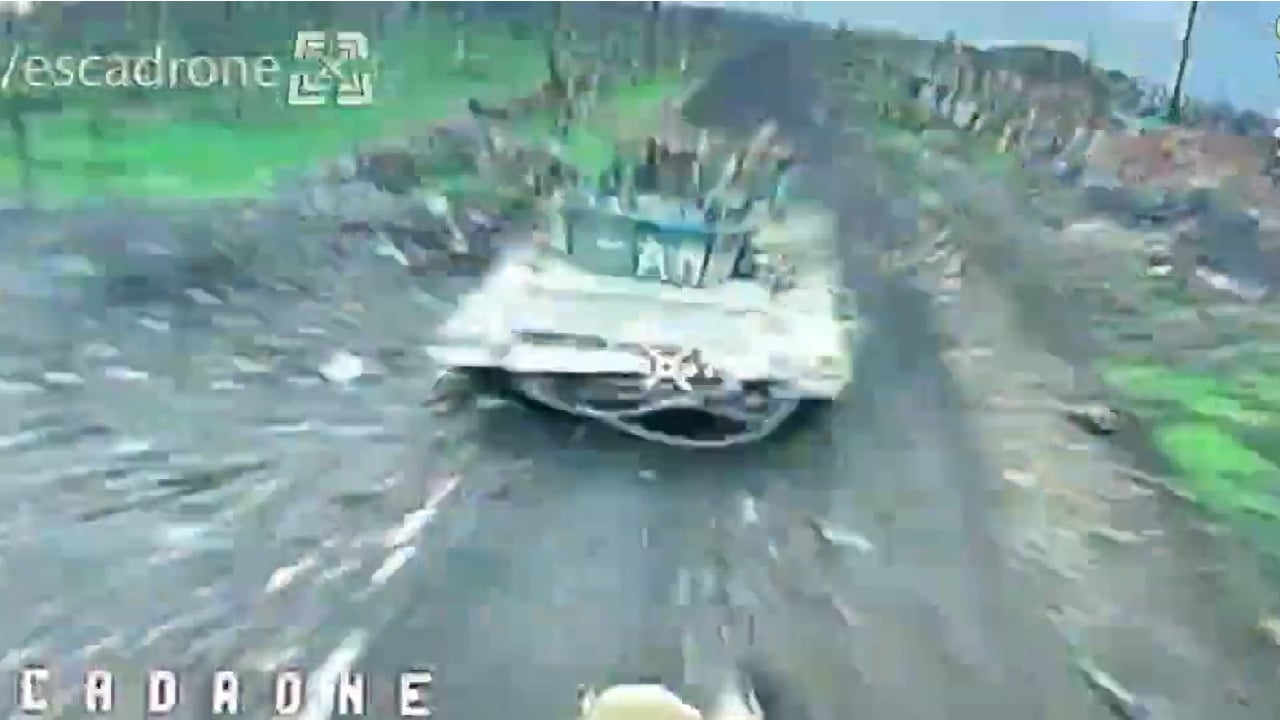The exact moment a Ukrainian first-person-view (FPV) loitering munition, armed with a PG-7 warhead, slammed into the rear engine deck of a Russian T-72B3 main battle tank (MBT) was captured on video and subsequently shared to social media.
Posted by open source intelligence watcher OSINTtechnical (@Osinttechnical) on Tuesday evening, the clip is the latest to show how a small unmanned aerial vehicle (UAV) carrying ordnance can be employed with deadly accuracy.
The incident reportedly occurred near the city of Marinka in the Donetsk Oblast.
Innovative Use of a HEAT Round
The Soviet-designed 85mm PG-7 is a high-explosive anti-tank (HEAT) surface-to-surface warhead that is typically employed from the RPG-7 man-portable launcher.
It is a spin and fin-stabilized rocket that incorporates a Point-Initiating Base-Detonating (PIBD) with self-destruct (SD) fuzing system. It is capable of penetrating 260 mm (10.2 inches) of rolled homogeneous armor (RHA).
When fired from the launcher, it has an approximate range of around 330 meters (1,082 feet) – but Ukrainian forces have discovered a way of employing the warhead to hit targets at a much greater range! Though it may not have destroyed the tank in the recent video, such a strike at the engine deck would have certainly disabled it, likely forcing the crew to abandon the vehicle.
Drone On
Subsequent drones could further ensure that the MBT isn’t returned to service. What is notable about this strategy is that it is low cost, while it puts no soldiers at risk of enemy fire. At worst, Ukraine would have been out of a drone and a warhead had the operation been unsuccessful.
As was reported earlier this week, Ukraine is now often employing small four-rotor commercial drones that sell for as little as $300.
These can be easily modified to carry enough explosives or other ordnance – including the PG-7 warhead – to destroy Russian tanks.
“Our team has done it many times. We have destroyed enemy tanks, heavy military equipment, personnel. It’s a very effective gadget,” a Ukrainian soldier, identified by the call sign Kakrurt, told Reuters in the central-eastern region of Dnipropetrovsk on Tuesday.
Another Tank Lost
Whether merely disabled or completely destroyed in the recent attack, the Russian T-72B3 is just the latest vehicle to litter the battlefield around Marinka, a city that had a pre-war population in excess of 9,000 and which now is a literal ghost town that has been likened to an “urban hellscape.” Drone footage recorded earlier this year showed the destruction of the small urban center.
In March, a Ukrainian soldier had reportedly taken out five Russian tanks near the city in a single day using U.S.-supplied FGM-148 Javelin missiles.
Earlier this year, it was reported that the Kremlin may have already lost half of its tanks in the fighting in Ukraine, exceeding 2,000 destroyed, disabled, or captured.
Marinka, Donetsk Oblast, a PG-7 armed Ukrainian FPV loitering munition slams into the engine deck of a Russian T-72B3 pic.twitter.com/6wt0UStTNl
— OSINTtechnical (@Osinttechnical) May 16, 2023
Author Experience and Expertise
A Senior Editor for 19FortyFive, Peter Suciu is a Michigan-based writer. He has contributed to more than four dozen magazines, newspapers, and websites with over 3,200 published pieces over a twenty-year career in journalism. He regularly writes about military hardware, firearms history, cybersecurity, politics, and international affairs. Peter is also a Contributing Writer for Forbes and Clearance Jobs. You can follow him on Twitter: @PeterSuciu.

